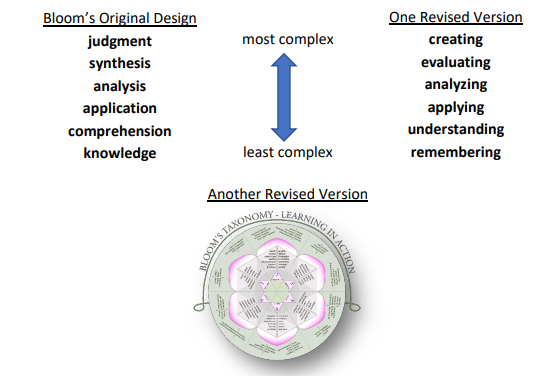Section Introduction- Analysis and Synthesis
What does it mean to know something? How would you explain the process of thinking? In the 1950s, educational theorist Benjamin Bloom proposed that human cognition, thinking, and knowing, could be classified by six categories.73 Hierarchically arranged in order of complexity, these steps were:

Since his original model, the taxonomy has been revised, as illustrated in the diagram below:

(click to enlarge)
- Each word is an action verb instead of a noun (e.g., "applying" instead of "application");
- Some words have been changed for different synonyms;
- One version holds "creating" above "evaluating";
- And, most importantly, other versions are reshaped into a circle, as pictured above.74
What do you think the significance of these changes is?
I introduce this model of cognition to contextualize analysis as a cognitive tool which can work in tandem with other cognitive tasks and behaviors. Analysis is most commonly used alongside synthesis. To proceed with the LEGO® example from Chapter 4, consider my taking apart the castle as an act of analysis. I study each face of each block intently, even those parts that I can't see when the castle is fully constructed. In the process of synthesis, I bring together certain blocks from the castle to instead build something else- let's say, a racecar. By unpacking and interpreting each part, I'm able to build a new whole.75
In a text wrestling essay, you're engaging in a process very similar to my castle-to-racecar adventure. You'll encounter a text and unpack it attentively, looking closely at each piece of language, it's arrangement, it's significance, and then use it to build an insightful, critical insight about the original text. I might not use every original block, but by exploring the relationship of part-to-whole, I better understand how the castle is a castle. In turn, i am better positioned to act as a sort of tour guide for the castle or a mechanic for the racecar, able to show my readers what about the castle or racecar is important and to explain how it works.

":jovian:" by bf8done is licensed under CC BY-NC 2.0 "lego pile" by justgrimes is licensed under CC BY-SA 2.0 "Brick Head" by DSC_0119 is licensed under CC BY-SA 2.0
Diagram: arrows indicatiing progression from a LEGO castle to a pile of LEGO bricks to a LEGO racecar.
In this chapter, you'll learn about crafting a thesis for a text wrestling essay and using evidence to support that thesis. As you will discover, an analytical essay involves every tier of Bloom's Taxonomy, arguably even including "judgement" because your thesis will present an interpretation that is evidence-based and arguable.
Chapter Vocabulary
| Vocabulary |
Definition |
| analysis |
the cognitive process and/or rhetorical mode of studying constituent parts to demonstrate an interpretation of a larger whole. |
| evidence |
a part or combination of parts that lends support or proof to an arguable topic, idea, or interpretation |
| synthesis |
a cognitive and rhetorical process by which an author brings together parts of a larger whole to create a unique new product. Examples of synthesis might include an analytical essay, found poetry, or a mashup/remix. |
| Thesis (statement) |
a 1-3 sentence statement outlining the main insight(s), argument(s), or concern(s) of an essay; not necessary in every rhetorical situation; typically found at the beginning of an essay, though sometimes embedded later in the paper. Also referred to as a "So what?" statement. |





